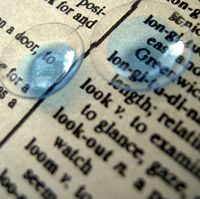Correct Punctuation
An Overview
Correct punctuation is an important part of every well written piece of English. You may have seen articles, essays and stories published in magazines or even online that did not use good basic punctuation. Looking at these hard to understand pieces of writing, you probably formed a low opinion of the publishing source. A poorly produced article, even if it has great content, will not command the time of the readers; readers will often leave the page before they finish the first paragraph. Remember, good content is not enough; it is the craftsmanship in the English language that matters.
Skilfully used punctuation makes the writing shine. A well punctuated piece of text is easier to read, because it avoids clutter and misinterpretations.
What is Punctuation?
Punctuation is a set of pre-defined symbols that enhance the understanding of the sentence-structure, and helps to stress certain parts of the speech or the writing. It is like a signal that tells you to change the rhythm of your speech while reading a sentence. You will be right to assume that flawless and correct punctuation is an aid to reading aloud.

There are several commonly used punctuation symbols in the English language including:
the period (.),
the comma (,),
the colon (:),
the semi-colon (;),
the question-mark (?),
the apostrophe (‘),
the exclamation mark (!),
the hyphen (-),
the dash (—),
and brackets (()).
Each of these has a usage assigned to it. Follow the links at the bottom of the page for more detailed information.
The symbols don’t make up your sentences obviously; you will still need all the other help of writing an essay, a paragraph or an outline. But the symbols make your writing more clear and understandable. The main purpose of writing is to convey the intended meaning, and symbols help in doing just that. The intentional pauses, stresses and organization of a writer’s work are all helped by using correct punctuation.
Some of the symbols listed above may have more than one use. What indication a symbol has depends on the context of your writing .
Let's explore few examples here. These sentences convey different meanings depending on whether or not, or how a punctuation symbol is used.
Example 1: Woman, without her man, is nothing.
Interpretation: At the risk of arousing hostility by female readers, I will say that the statement means that a woman needs a man to be complete.
Example 2: Woman: without her, man is nothing.
Interpretation: This one conveys something very different about a woman; it says that a man without a woman is nothing.
Did you notice how a sentence with the exactly same words can be interpreted in completely different ways, in fact, completely opposite ways by different usages of punctuation?
Let’s see another example.
Example 3: Eats shoots and leaves.
Interpretation: Someone (or some animal) is very interested here in eating new branches of a tree along with its leaves.
Example 4: Eats, shoots and leaves.
Interpretation: A person has a gun, he (or she) first eats something, then fires the gun and leaves the place.
The second set of examples is again conveying different meanings, two sets of it.
Now that you’ve looked at what a misplaced or excess punctuation can do, imagine how would you like it if your writing was misinterpreted in that way. Get the point? Good.
Takeaway:
Realize the importance of correct punctuation that generates a good, flawless understanding of your English writing. Learn more about different symbols on our website by following the appropriate links.
Using Periods and Commas
Using Question Marks and Exclamation Marks
Using Colons, Semicolons and Apostrophes
Using Quotations, Hyphens, Dashes and Brackets
Look At Some Of The Common Punctuation Mistakes
Return From Correct Punctuation To Home Page
